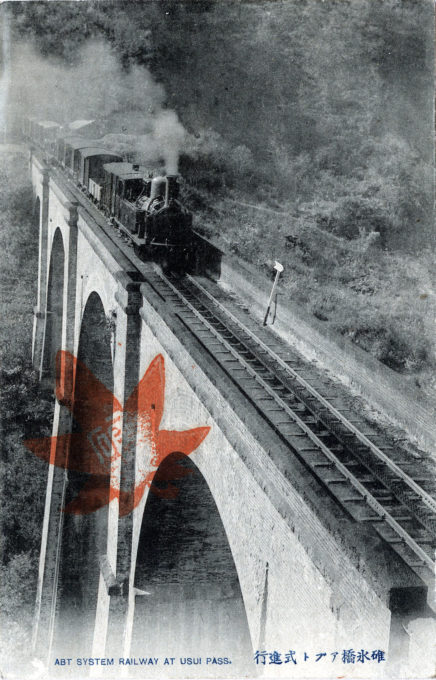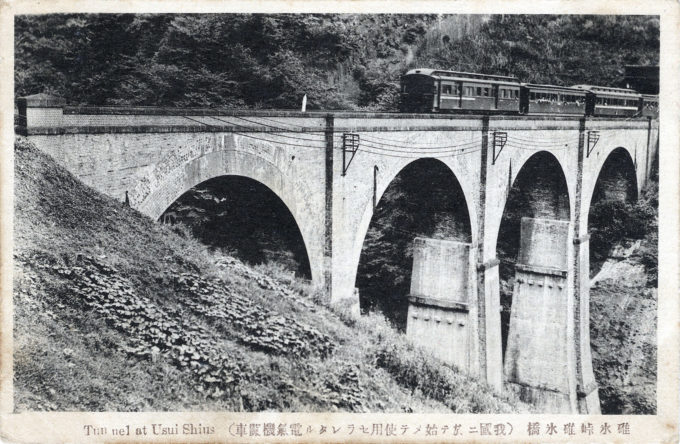“The Abt rackrail section across the Usui Pass is located 3,000 ft. above sea-level, and the difference in level amounts to 1,817 ft. [over] a length of 6.9 miles. This steep section was electrified in 1912. Twelve rack electric locomotives are in service, each capable of drawing, at a speed of 11 mi. per hour, 8 cars on a gradient of 6 percent.
“The power is supplied by a power station at Yokogawa, specially erected for the purpose and containing three 1,000 k.w. vertical turbo-generators. There are substations at the highest and the lowest point of the rack section.”
– The Japan Year Book: Complete Cyclopaedia of General Information and Statistics on Japan and Japanese Territories, 1923

“Abt system railway at Usui Pass”, Karuizawa, c. 1910, before electrification of the railway in 1912. The Abt system was devised by Carl Roman Abt, a Swiss locomotive engineer, in 1882 as a cheaper, technical improvement over the previous Riggenbach cogged rail system. An Abt system has solid racks of offset teethed bars mounted centrally between the rails. When the Shin-etsu railway was completed in 1888, it initially operated a horse-drawn tram through the Usui Pass between Yokokawa and Karuizawa stations – where the grade exceeded 6% – until 1893 when an Abt system was installed.through the pass. The Abt remained in use in use until 1963 when modern non-rack electric locomotives were introduced.
See also:
Karuizawa Station, c. 1935.
Karuizawa, c. 1920.
“Straddling Gunma Prefecture and Nagano Prefecture, the Usui Pass played an important role in connecting the Kanto region and Nagano but was notorious for being a difficult journey by train.
“The Shin-etsu Line train stops Yokokawa Station on the Gumma side and Karuizawa Station on the Nagano side were only 11.1km (6.7-miles) apart; the elevation difference, however, was over 550m (1500 feet). The Usui Pass had steep gradients of up to 6.7%, and was where Japan’s first Abt-system (rack and pinion) railway was laid.
“… The ‘Usui 3rd Bridge’ is definitely one of the highlights of the Abt Road. Made up of over 2 million red bricks, this bridge an architectural marvel. Built in 1892, this historic bridge was formerly used by trains travelling between Yokokawa and Karuizawa, and is affectionately dubbed Meganebashi (‘eyeglasses bridge’) as its four arches resemble a pair of glasses.
“Tunnel at Usui Shiu”. The Usui 3rd Bridge between Yokokawa and Karuizawa stations on the Shin-etsu Line, c. 1920.
“The Usui 3rd Bridge is Japan’s largest arched brick bridge, and is an Important Cultural Property, together with other structures of the former Usui Pass Railway.
“In 1963, the Abt-system railway was abandoned with the switch to electric locomotives, and in 1997, the Nagano Shinkansen (now Hokuriku Shinkansen) opened, eliminating entirely the Shinetsu express train service once offered between Nagano and Tokyo.”
– “Hiking an abandoned railway: Abt Road and the Usui Pass”, Japan Rail Cafe, October 2022



Pingback: Hakone Mountain Electric Railway Co., c. 1920. | Old TokyoOld Tokyo
Pingback: Karuizawa Station, c. 1935. | Old TokyoOld Tokyo